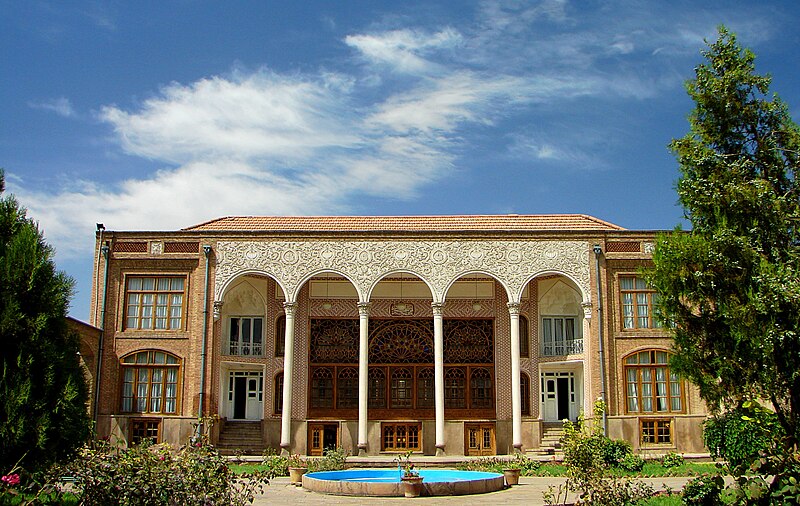| BayaniBehnam's House, Sahand University of Technology, Tabriz, Azerbaijan, Iran, 08-19-2006.jpg |
Last two days me and Somayeh were in another lovely city of Iran, named Tabriz, located in north western part of Iran, Azerbaijan state.
This old house is build on about 100 years ago, which is now part of architecture department of Sahand University of Technology.
The place name is "Behnam's House", but unfortunately I don't know who was Behnam, and there were no man whom I could ask this him there.
Tabriz, from Wikipedia:
Tabriz (Persian: تبریز , Azerbaijani: Təbriz) is the largest city in north-western Iran with a population of 1.2 million people. Tabriz is situated north of the volcanic cone of Sahand south of the Eynali mountain. It is the capital of East Azarbaijan Province.
Tabriz is the main cultural center of Iranian Azarbaijan, and most of its people are Azerbaijanis.
Historically, the founding of the city is shrouded in mystery. Most sources mention the Sassanid era, while others believe it to be even further back in history. After the Turkic invasion of Iran, Tabriz later became the capital of the Ilkhanate empire from about 1270 to 1305, of the Aq Quyunlu from about 1469 to about 1502, and of the Safavids from 1502-1548. It also fell under Ottoman rule for some time during the time of the Safavids,.
Research by British Egyptologist and historian David Rohl suggests that the Biblical Garden of Eden was situated here. His findings were published in his book Legend: The Genesis of Civilisation and then made into a documentary for the Discovery Channel.[citation needed]
Violent earthquakes have wiped out most of the historic monuments of Tabriz. One important monument that has survived these earthquakes is the Tabriz Citadel (Ark-e Tabriz or Ark-e Ælishah), a ruin of vertical book-shaped elements. The Blue Mosque of Tabriz (Göy-Mæčid), is another important monument in the city.
Shah Goli.
Enlarge
Shah Goli.
Tabriz is where the constitutionalists of Iran was centered during the early 20th century. An American who died defending the Constitutional Revolution, Howard Baskerville, is buried in Tabriz. The famous Iranian historian and philosopher, Ahmad Kasravi, was born in a nearby village called Hokmavar. Samad Behrangi, a famous writer and musicians, along with Ali Salimi, Vahid Houseini, and Qolamhossein Bigjekhani were tar specialists from this city.
Daytime temperatures usually reach at least 30 degrees Celsius (high 80s Fahrenheit) in July and August and drop below freezing in January.
More info can be found on " en.wikipedia.org/wiki/Tabriz
Special license granting for WikiPedia: This photo can be used under " CC-BY-3.0 just on WikiPedia (*.wikipedia.com) and WikiMedia (*.wikimedia.com). |
Izini
(Sake amfani da wannan fayil) |

|
This image, which was originally posted to Flickr, was uploaded to Commons using Flickr upload bot on 14 Yuni 2008, 22:24 by Le Behnam. On that date, it was confirmed to be licensed under the terms of the license indicated.
|
- Za ka iya:
- a raba – dan kwafa, yadawa da aika aikin
- dan maimaita – dan daukar aikin
- A karkashin wannan sharuddan
- Jinginarwa – Dole ku bada jinjina da ta dace, samar da linki zuwa lasisin, da kuma bayyana ko kunyi sauyi. Zaku iya haka ta yadda ta dace, amma ba kowace hanya ba wanda zai nuna mai-lasisin yana goyon bayan ku ba ko goyon bayan amfanin da kuke yi ba.
- Yada ahaka – Idan kuka maimaita, sabuntawa, ko kari akan wannan, dole ku bayar da gudunmuwar ku karkashin iri daya ko lasisi data dace kamar na asali.
https://creativecommons.org/licenses/by-sa/2.0CC BY-SA 2.0 Creative Commons Attribution-Share Alike 2.0 truetrue |


